If you are feeling mental fog in your brain, unrest in life, and want to escape from your daily routine, the Himalayas are the perfect destination for peace and rejuvenation. Among all the serene locations in the Himalayas, Harsil Valley stands out as an untouched paradise. Harsil is a beautiful village, a tourist hill station, and an army base located on the banks of the Bhagirathi River, on the way to Gangotri in the Uttarkashi district of Uttarakhand, India.
Situated at an altitude of 9,005 ft (2,745 meters) above sea level, Harsil lies 78 km from Uttarkashi and 30 km from Gangotri National Park, which spans 1,553 square km. The region is renowned for its natural beauty and apple production.
Starting the Journey – Escaping the Daily Chaos

Feeling frustrated and directionless, my friend Aman and I decided to embark on a road trip to Uttarakhand to find solace. We planned our route from Himachal Pradesh to Uttarakhand by road. After packing our bags and fueling up our car, we started our journey.
Our first stop was Rishikesh, where we arrived late at night after driving 200 km. We stayed at Bhagirathi Dham Ashram, explored Rishikesh, and attended the Ganga Aarti at Parmarth Niketan, where the first wave of peace touched my soul. I felt lighter, as if the divine energy of the Ganges had begun to cleanse my troubled mind.
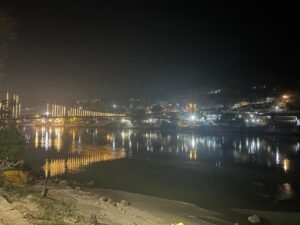
The Drive from Rishikesh to Uttarkashi
Determined to reach Uttarkashi early, we woke up at 4 AM and resumed our journey. The distance from Rishikesh to Uttarkashi is around 160 km, and we decided not to stop until we reached our destination, except for a short tea break. The road was in excellent condition since it was a part of National Highway NH7. Aman and I took turns driving, covering half the distance each.
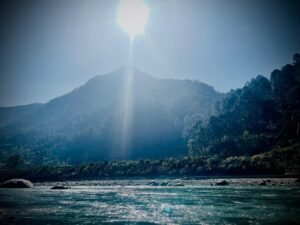
By 9 AM, we reached Uttarkashi and immediately headed to the Ganges River for a holy dip. The water was freezing cold, coming straight from the Gomukh glacier. At first, the chill sent a shock through my body, making me feel as if my blood had frozen, but the experience was refreshing and purifying. After basking in the morning sun, I took another dip, and in that moment, all my worries seemed to wash away with the flowing river. Maa Ganga cleansed not only my body but also my mind and soul.
Spiritual Stop: Kashi Vishwanath Temple
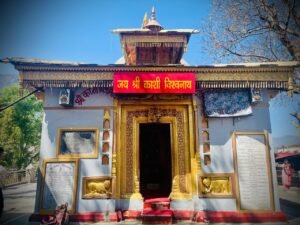
After the bath, we visited the Kashi Vishwanath Temple, which is 154 km from Rishikesh on the Rishikesh-Gangotri route. This ancient shrine is dedicated to Mahadev, and its divine aura can be felt as soon as one enters the premises. Inside the temple complex is the Shakti Temple, which houses an enormous 26-foot-high brass trident. According to inscriptions, the temple was built by King Ganeshwar, and his son Guh erected the trident.
Unlike other crowded temples, this sacred site was peaceful, allowing us to experience an uninterrupted darshan. The environment was calm, and the priests were welcoming. This visit filled us with immense positivity and gratitude.
A Taste of Uttarakhand’s Authentic Cuisine
After our spiritual experience, we set out for breakfast. I had heard that Garhwal cuisine is renowned worldwide, and we found a small dhaba near Uttarkashi’s main market. The food was prepared with love, and the taste was uniquely delicious, especially the garlic-infused dish. The chef, a humble and kind-hearted local, made sure we enjoyed every bite.
The Thrilling Road to Harsil Valley
With satisfied stomachs, we began our adventurous drive to Harsil Valley, also known as the Mini Switzerland of India. The air became cooler, and the fresh Himalayan breeze touched our skin as we ascended.
The road to Harsil is single-lane, partially paved, and prone to damage from landslides. The journey was filled with sharp curves, high rocky mountains, and continuous rockfall zones. Several times, we encountered falling stones, and the risk of a broken windshield was high. However, the beauty of the landscape and the thrill of the journey made the challenges worthwhile.
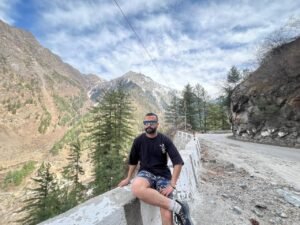
Although Uttarkashi to Harsil is only 70-80 km, the rough terrain made the drive time-consuming but exciting. The last 10 km before reaching Harsil were the most breathtaking—the Bhagirathi River flowing alongside snow-capped peaks created an ethereal view. Every turn presented a new postcard-worthy scene, compelling us to stop frequently to capture the mesmerizing beauty.
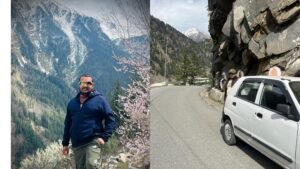
Arrival at Harsil –A Slice of Heaven
Upon reaching Harsil Village, we were spellbound by its beauty. Surrounded by lush green deodar forests and majestic mountains, the valley radiates an unparalleled energy.
Where to Stay?
For accommodation, visitors can book a Snow Pod Stay, which resembles an igloo, offering a unique experience. Sitting beside the Bhagirathi River, breathing in the fresh mountain air, and listening to the calming sound of flowing water—this was pure bliss.
What to Do in Harsil
In the tranquil environment of Harsil, one can meditate, embrace solitude, and feel spiritually connected to nature. The valley is only 26 km from Gangotri, so if time permits, visiting the revered Gangotri Temple is highly recommended.
How to Reach Harsil?
By Air
The closest airport is Jolly Grant Airport, Dehradun (240 km away). From there, you can hire taxis or take a bus to Uttarkashi and then Harsil.
By Train
The nearest station is Rishikesh (215 km away). Taxis and buses run regularly from there.
By Road
We drove ourselves, and the drive from Dehradun, Rishikesh, and Haridwar to Harsil is well-connected.

Final Thoughts – A Journey to Remember
The journey to Harsil Valley was not just an adventure but a soulful experience that rejuvenated my mind and spirit. Away from the chaos of city life, this hidden gem in the Himalayas provided the perfect escape, bringing peace and clarity.
From the challenging road trip through treacherous terrains to the divine blessings of the Ganges and Lord Shiva, everything about this journey was surreal. If you seek adventure, serenity, and a break from routine, Harsil Valley should be at the top of your travel list.
Experience the Himalayas, embrace the adventure, and let nature heal your soul.
You can read our other article here.
The Risky Path: A Himalayan Expedition – Conquering Friendship Peak
